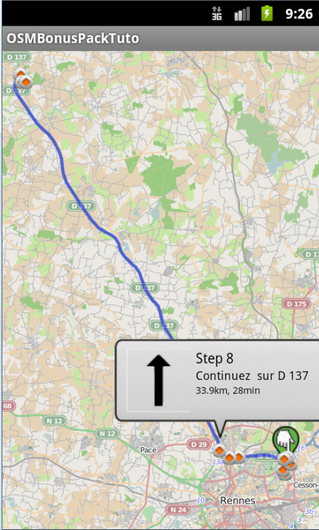-
Notifications
You must be signed in to change notification settings - Fork 205
Tutorial_1
We assume you already followed Tutorial_0.
First, get a road manager:
RoadManager roadManager = new OSRMRoadManager(this);Set-up your start and end points:
ArrayList<GeoPoint> waypoints = new ArrayList<GeoPoint>();
waypoints.add(startPoint);
GeoPoint endPoint = new GeoPoint(48.4, -1.9);
waypoints.add(endPoint);And retreive the road between those points:
Road road = roadManager.getRoad(waypoints);then, build a Polyline with the route shape:
Polyline roadOverlay = RoadManager.buildRoadOverlay(road, this);Add this Polyline to the overlays of your map:
map.getOverlays().add(roadOverlay);And then? Refresh the map!
map.invalidate();-
Okay, but I wanted this route for bicycles...
-
First, change to MapQuestRoadManager, as it supports bicycle routes. Bad news, MapQuest service now requires an API key, so you will also have to register at http://developer.mapquest.com, and obtain this API key.
Then, in the code, just few changes, not too complicated:
RoadManager roadManager = new MapQuestRoadManager("_YOUR MAPQUEST API KEY_");Then set appropriate option (before getting the road):
roadManager.addRequestOption("routeType=bicycle");(all MapQuest options are described here: http://open.mapquestapi.com/guidance/)
Done.
At each road node, we put a Marker. Straightforward:
Drawable nodeIcon = getResources().getDrawable(R.drawable.marker_node);
for (int i=0; i<road.mNodes.size(); i++){
RoadNode node = road.mNodes.get(i);
Marker nodeMarker = new Marker(map);
nodeMarker.setPosition(node.mLocation);
nodeMarker.setIcon(nodeIcon);
nodeMarker.setTitle("Step "+i);
map.getOverlays().add(nodeMarker);
}You don't have a marker_node icon? Shame on you. Pick the OSMNavigator one (res/drawable-nodpi/marker_node.png).
Here we are! Clicking on a step marker will open its bubble.
-
Hey, guy, those bubbles are nice, but useless!
-
You are right. So, go to step 4.
Set the bubble snippet with the instructions:
nodeMarker.setSnippet(node.mInstructions);Set the bubble sub-description with the length and duration of the step:
nodeMarker.setSubDescription(Road.getLengthDurationText(this, node.mLength, node.mDuration));And put an icon showing the maneuver at this step:
Drawable icon = getResources().getDrawable(R.drawable.ic_continue);
nodeMarker.setImage(icon);Give it a try, you should get something like that:

And, yes, you are right, maneuver icons are not correct!
The maneuver id is in node.mManeuverType. The possible maneuver ids are here. And the maneuver icons are in OSMNavigator res/drawable-mpi. It's boring, so I'm going downstair to take a coffee, while you handle those icons properly.
And see you again on Tutorial_2.